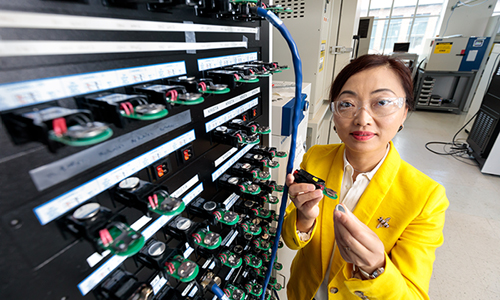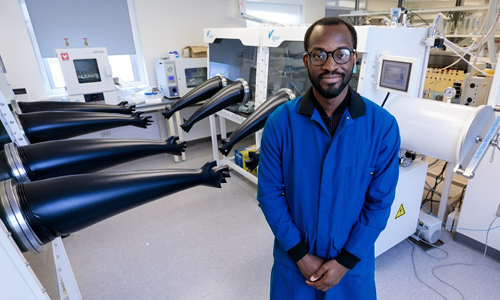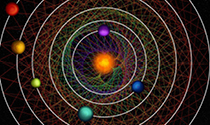|
|
|
|
| |
Current events in battery science |
|
| |
|
|
|
| |
Modern life is powered by batteries. As you read this, you’re surrounded by them—in your mobile phone, your wireless mouse, your home’s smoke detector, your car, and so on. These energy savers will help galvanize the global shift toward decarbonization, with UChicago researchers leading the way in battery breakthroughs. They are building on an institutional history that includes the work of 2019 chemistry Nobelist John B. Goodenough, SM’50, PhD’52, who developed the lithium-ion battery—now a mainstay in the push toward a carbon-free future. |
|
| |
|
|
|
| |
A “doctor for batteries” aims to heal climate wounds |
|
| |
|
|
|
|
|
| |
| |
|
|
| |
Using high-powered microscopy to see how particles inside lithium-ion batteries change over time, researchers shed new light on how to make longer-lasting batteries. (Photography by John Zich) |
|
| |
|
|
|
|
| |
|
|
|
| |
While rechargeable lithium-ion batteries have come a long way in efficiency since the late 1970s, their life span dwindles after just a few hundred charge cycles. Improving these, says Y. Shirley Meng, is the key to a cleaner, greener, decarbonized planet. The Pritzker School of Molecular Engineering professor and her team use imaging techniques and computational modeling to diagnose weaknesses that cause battery death. “Doctors seek to prolong human life,” Meng said in a TEDxChicago talk this past October. “As a doctor for batteries, that’s what we do.” |
|
| |
|
|
|
|
|
|
|
| |
|
|
|
| Molding the future: Scientists at UChicago have created a material that is malleable and stable like plastic but has the conductivity of a metal. This “conductive Play-Doh” could prove invaluable for designing electronics to withstand harsh conditions. |
|
|
|
| |
|
|
|
|
|
|
|
|
|
| |
|
|
|
| Light bulb moments: During the second annual Battery Day at the Museum of Science and Industry, students from the Pritzker School of Molecular Engineering taught local families to build battery-powered devices, getting young people engaged in battery science. |
|
|
|
| |
|
|
|
|
|
| |
Forging a new path in lithium-metal |
|
| |
|
|
|
|
|
| |
| |
|
|
| |
New research from the lab of molecular engineer Chibueze Amanchukwu alters electrolyte compositions to create energy-dense, safe batteries, opening new possibilities for EVs and grid-scale renewable energy storage. (Photography by John Zich) |
|
| |
|
|
|
|
| |
|
|
|
| |
Lithium-metal batteries have a higher power potential than lithium-ion batteries, but they’re more unstable and prone to exploding. Chibueze Amanchukwu, Neubauer Family Assistant Professor of Molecular Engineering, and his lab are testing composition changes to the electrolytes that give batteries their conductivity. These could lead to safer, more powerful batteries for use in electric vehicles and large-scale renewable energy storage—which may not be possible with lithium-ion batteries alone. |
|
| |
|
|
|
|
|
|
|
| |
| |
|
|
| |
The Oobleck effect:
Non-Newtonian fluids, drug synthesis techniques, and mammals’ brain development are a few of the topics covered in the January 2024 µChicago.
|
| |
|
|
|
| |
A dance to the music of the spheres:
Astrophysicists identify a rare gravitational pattern, and a study makes strides in the science of fear. These stories and more in the December 2023 µChicago.
|
| |
|
|
|
|
|
|
| |
|
|
|
|
|
| |
| |
Sign up to receive µChicago monthly. |
|
|
|
| |
|
|
|
|





